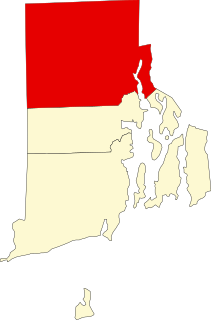
The William Whalley Homestead is an historic farmstead at 33 Burchard Avenue, Little Compton, Rhode Island. The main house is a 1-1/2 story wood frame structure, probably built sometime between 1815 and 1830. The property includes a barn and second outbuilding dating to the late 19th century, bounded by a low stone wall. The main house is a fairly typical Cape style house, five bays wide, with a central chimney. The property as a whole is a well-preserved example of a typical 19th-century farmstead in the area.

The Lawton–Almy–Hall Farm is an historic farm at 559 Union Street in Portsmouth, Rhode Island. The farm comprises 40 acres (16 ha) of land, and a well-preserved farm complex with elements dating to the 18th century. The land was first granted in 1648 to George Lawton, and was owned by six generations of the family. It was acquired in 1832 by Pegel Almy, whose family owned it until 1938, when it was sold to the Halls. The farmhouse is one of the oldest in the area, with its northern section estimated to have been built about 1700, based on stylistic resemblance to the Quaker Meetinghouse and a local schoolhouse.

The Dexter Arnold Farmstead is a historic farmstead on Chopmist Hill Road in Scituate, Rhode Island. The main house, a 2-1/2 story wood frame structure five bays wide, with a large central chimney, was built in 1813. The 3.6-acre (1.5 ha) property also has five outbuildings which appear to be near contemporaries to the house, a relative rarity in rural Rhode Island. The main barn survived into the 20th century, but was destroyed by the New England Hurricane of 1938. The property also includes a small family cemetery. The house, built by Dexter Arnold in land belonging to his father, remained in family hands until 1975.
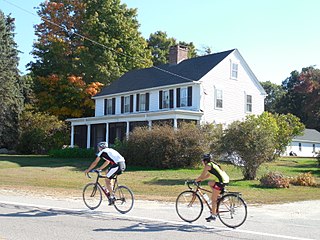
The Mathewson Farm is an historic farm on 544 Greenville Avenue in Johnston, Rhode Island. It is an agricultural remnant of the formerly rural village of Belknap. The centerpiece of the farm complex is a late 18th-century farmhouse with vernacular Federal styling. Surviving outbuildings of the farm include a barn from the early 20th century, a henhouse, and a silo. This property was developed as a farm by William Mathewson in the 1790s, and was actively farmed by his descendants until the 1940s.
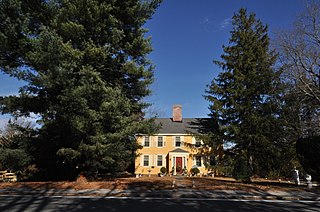
The Whipple–Cullen House and Barn is an historic farmstead on Old River Road in Lincoln, Rhode Island. The main house is a 2-1/2 story wood frame structure, five bays wide, with a large central chimney and a gable roof. An addition extends to the rear, and a 19th-century porch is on the side of the house. The barn, dating to the late 19th century, is north of the house, and there is a former farm shed, now converted to a garage, to its south. The property is located across the street from the Lincoln town offices. The house, built c. 1740, is one of the town's least-altered 18th century houses, and the barn is a rare survivor of the town's agrarian past.

St. Joseph's Church Complex is an historic Roman Catholic church complex at 1303 Mendon Road in Cumberland, Rhode Island within the Diocese of Providence. It includes a Gothic Revival style church along with two late 19th-century, clapboard-sheathed, wood-frame structures on the east side of Mendon Road.
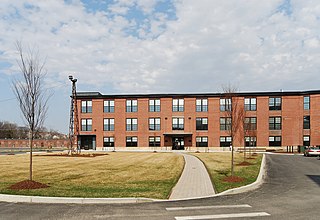
The United States Rubber Company Mill Complex is a historic industrial facility in Providence, Rhode Island. It is a large complex of factory buildings covering about 23 acres (9.3 ha) on the north bank of the Woonasquatucket River. It is bounded on the west by Ericson Place, the north by Valley Street, and the east by Hemlock Street. The property includes 29 historic buildings, built between c. 1885 and c. 1960, as well as three bridges. The buildings are predominantly brick structures, ranging in height from one to five stories, and were built either by the Joseph Banigan Rubber Company, its successor the United States Rubber Company, or the American Locomotive Company, whose property east of the rubber works was acquired by the US Rubber Company in 1918. Only four buildings built by these companies are known to have been demolished before 1960. The plant closed in 1975, and has since been adapted to a variety of other uses.
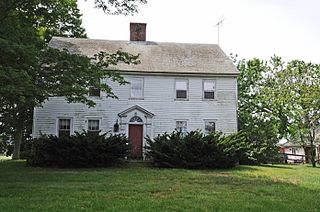
The Cottrell House is an historic complex at 500 Waites Corner Road in South Kingstown, Rhode Island. The house is the centerpiece of a working farm complex which includes 73 acres (30 ha) of land, and is one of South Kingstown's last working farms. The house, built c. 1790, is a fairly typical Federal style structure, 2-1/2 stories tall, five bays wide, with a large central chimney. The main barn, located south of the house, is believed to be contemporary to the house, although it has undergone some alteration and extension in the 20th century.

The Henry Eldred Farm is an historic farm complex at 368 Old North Road in South Kingstown, Rhode Island. The main block of the farmhouse, a 2-1/2 story wood frame structure, was probably built c. 1822, although there is architectural evidence suggesting it may be an enlargement of an older structure. Its simple Federal styling is distinctly rural and vernacular in character. The complex also includes a cluster of buildings dating to the mid-19th century, including a barn, carriage house, shed, and blacksmith shop.

The Kingston Hill Farm, also known as the Potter-Peckham Farm, is a historic farm at 549 Old North Road in South Kingstown, Rhode Island. The 20-acre (8.1 ha) farm is centered on a building complex with a c. 1810 1-1/2 story wood frame farmhouse, which follows a typical plan of five bays with a central chimney. Behind the house are a seed barn and wagon shed, both dating to the early 20th century. A family cemetery with 18th-century graves is located near the southern boundary of the property. The farm was first established by William Potter in the 1730s; by the early 18th century it came into the hands of Elisha Reynolds Potter, who operated it as a tenant farm. Potter tore down the original farmhouse and built the now-surviving smaller house.
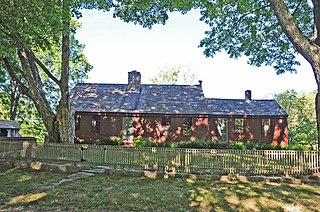
The Simon Lillibridge Farm is an historic farm property at 75 Summit Road in Exeter, Rhode Island. The 38-acre (15 ha) property is all that remains of an original 200-acre (81 ha) parcel purchased by Simon Lillibridge in the 1810s. The main house, a two-story wood frame structure, was either built by Lillibridge, or was already on the property when he bought it. Architectural analysis of the house suggests that at least portions of it were built in the 18th century, with hand-hewn beams, and other stylistic elements suggesting construction during the Georgian period. The farm complex includes other 19th-century buildings, including a barn, shed, wagon shed, and outhouse, as well as a family cemetery. The property was in regular agricultural use until about 1935, and was used thereafter as a summer residence.

The Henry Marchant Farm is an historic farm on South County Trail in rural western South Kingstown, Rhode Island. The main house of the farm is a 2-1/2 story wood frame structure, probably built by Joseph Babcock. Construction is traditionally dated to the 1750s, but architectural evidence suggests it may have been built earlier—possibly between 1720 and 1740. The house has well-preserved vernacular Federal styling, including a main entry framed by Doric pilasters and an entablature. The farmstead includes an early 20th-century barn, a carriage house, and an old privy, as well as the family cemetery of the Marchant family. The property was purchased in 1774-75 by Henry Marchant, a leading Newport merchant and politician.

The Commodore Oliver Perry Farm is an historic farm on United States Route 1 in South Kingstown, Rhode Island. The farm consists of 250 acres (100 ha) of rolling fields and woodlands on the west side of the road. The main farm complex includes a wood-frame house, barn, a caretaker's residence, and a number of other outbuildings, accessed via a winding private lane. The main house, a two-story gambrel-roofed structure, is of uncertain construction date, and is generally dated to either 1785 or 1815. It has been extensively altered, and been the subject of well-meaning but historically problematic restorations in the first half of the 20th century.

The Joseph Pierce Farm is an historic farm at 933 Gilbert Stuart Road in North Kingstown, Rhode Island. It consists of 18 acres (7.3 ha) of land, along with an 18th-century farmhouse and a number of 19th-century outbuildings. The oldest portion of the house, its southern ell, was originally built with a gable roof, but this was extended to the north in the late 18th or early 19th century, and given it present gambrel roof and Federal styling. Later additions in the 19th and 20th centuries gave the house its present cruciform appearance. Outbuildings dating to the 19th century include a barn with attached privy, a toolshed, and a henhouse. The complex is a well-preserved reminder of the area's rural heritage.

Willow Dell, also known as the Weeden Farm, is an historic farmhouse on 2700 Commander Oliver Hazard Perry Highway in South Kingstown, Rhode Island. It is located on the south side of the highway, just west of Matunuck Beach Road, on a 7-acre (2.8 ha) parcel of land. The main block of the 2-1/2 story gambrel-roofed house was built c. 1752 by Colonel Jeremiah Bowen, and was purchased in 1826 by Wager Weeden, whose descendants still own the property. The property includes two barns, a garage, and a stable which has been converted to residential use, as well as the Wager Weeden Memorial Fountain, visible on the south side of the highway by a stone marker.

The Upper Rockville Mill is an historic mill complex at 332 Canonchet Road in Hopkinton, Rhode Island. The complex occupies about 0.5 acres (0.20 ha) of land, and includes two buildings, the site of a third, and their associated waterworks, including Wincheck Pond and surviving raceway elements. The two buildings are the main mill building, a 3-1/2 story stone structure built 1844-45, and a two-story auxiliary building added in the 1860s. The Rockville Manufacturing Company, which operated the mill, was a major employer and landowner in the area for much of the 19th century. The property was operated by a variety of textile concerns until 1953, when the property was briefly owned by the Boy Scouts of America (BSA), whose Camp Yawgoog, located on the shores of Wincheck and Yawgoog Ponds, was affected by the mill's water rights. The BSA retained the water rights and sold off the rest of the property.

The Green–Bowen House is a historic house at 100 Mill Wheel Road in Warwick, Rhode Island, United States. It is a late-date stone-ender house, built c. 1715, and is the oldest surviving house of the locally historically prominent Greene family. It stands on land purchased by John Greene from local Native Americans in 1642, and was probably built by Fones Greene not long after he acquired the land in this area in the early 18th century. The house has a two-story main block, with two rooms on each floor, and its west wall and chimney are built of brick instead of stone. Shed-roof additions dating to 18th century were added abutting the west side and the rear. The property it stands on includes a 20th-century house, and a 19th-century barn and cottage.

The Wilbor House is a historic house museum at 548 West Main Road in Little Compton, Rhode Island, and currently serves as the headquarters of the Little Compton Historical Society. The property includes eight buildings of historical significance, six of which were part of the Wilbor farmstead, a complex that was used for farming between 1690 and 1955, when the property was acquired by the historical society. The house is a 2-1/2 story wood frame structure, whose oldest portion was probably a stone ender built by Samuel Wilbor, and whose western half was added c. 1740, giving it a Georgian appearance. The five farm outbuildings all date to the 19th century.
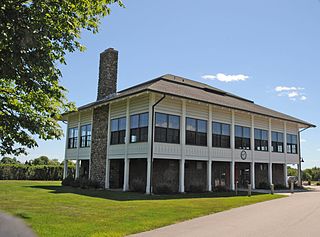
The Anthony–Kinney Farm is an historic farm and resort complex at 505 Point Judith Road in Narragansett, Rhode Island. The property, now a town-owned recreation area known as Sunset Farm, saw agricultural use for over 300 years, and was converted into a private resort around the turn of the 20th century. The Point Judith area was among the first in Rhode Island to be purchased from the local Narragansett people, in 1657. The farm was acquired by James E. Anthony in 1850, who sold it to Francis Kinney in 1897. Kinney maintained much of the land in agricultural use, but built an extravagant resort complex, including a distinctive East Indian bungalow as a clubhouse, and built a private nine-hole golf course. Kinney died in 1908, and the property was owned by the Chase family until 1991, when most of it was purchased by the town. It is managed by the town as an active farm, and the restored clubhouse is available for rent as function space.

The Esten–Bowen House is a historic house at 199 Iron Mine Road in Burrillville, Rhode Island. The 1 1/2 story timber frame Cape style house was built c. 1790 by John Esten, a major landowner in eastern Burrillville in the second half of the 18th century. The main block is five bays wide and two deep, with a massive central chimney. A kitchen ell to the right of the main block appears to be an early addition. The house was held in the Esten family until 1879, by which time its surrounding property had been reduced to just 30 acres (12 ha). This property was acquired by Esther Bowen in 1941 and the house was rehabilitated, with modest Colonial Revival alterations. The property includes a 19th-century shed, and foundational remnants of a blacksmithy and barn.






